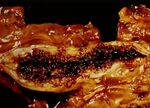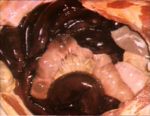Difference between revisions of "Intestinal Arterial Thromboembolism"
Jump to navigation
Jump to search
m (Text replace - "[[Small Intestine - Anatomy & Physiology|" to "[[Small Intestine Overview - Anatomy & Physiology|") |
|||
| Line 28: | Line 28: | ||
* See sharply delineated dark areas in bowel that are flaccid with loss of tone. | * See sharply delineated dark areas in bowel that are flaccid with loss of tone. | ||
** These become necrotic followed later by peritonitis.[[Category:Intestine_-_Vascular_Disturbances]] | ** These become necrotic followed later by peritonitis.[[Category:Intestine_-_Vascular_Disturbances]] | ||
| − | [[Category:Dog]][[Category:Cat]] | + | [[Category:Intestinal Pathology - Dog]][[Category:Dog - Cardiovascular System]][[Category:Cat]] |
[[Category:To_Do_-_Clinical]] | [[Category:To_Do_-_Clinical]] | ||
[[Category:Cardiovascular_Disorders_-_Horse]] | [[Category:Cardiovascular_Disorders_-_Horse]] | ||
[[Category:Small_Intestinal_Disorders_-_Horse]] | [[Category:Small_Intestinal_Disorders_-_Horse]] | ||
Revision as of 18:36, 14 December 2010
- Non-strangulation infarction.
- There is often a functional obstruction at point of infarction.
- Relatively rare as the bowel has a good anastomosing blood supply.
Horses
- E.g. Strongylus vulgaris larvae migrating in cranial mesenteric artery in horse
- Cause arteritis with thickening of wall
- Due to fibrin and debris deposition and hypersensitivity reaction
- Leads to vasoconstriction
- May occlude lumen and encourage thromboemboli.
- Can cause ischaemic necrosis of a segment of small intestine
- Is less common now that Strongylus vulgaris infections are declining.
- Cause arteritis with thickening of wall
- E.g. equine salmonellosis.
Small Animals
- Especially dogs
- Road traffic accidents produce and infact in the gut.
- Renal disease also causes infarction.
- Particularly nephrotic syndrome.
- Anticoagulant proteins are lost in the urine, leading to a prothrombic state in the ciruclation.
Pathology
- Similar to that caused by venous congestion.
- See sharply delineated dark areas in bowel that are flaccid with loss of tone.
- These become necrotic followed later by peritonitis.

